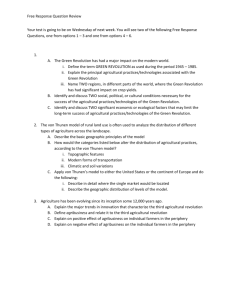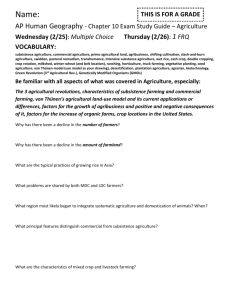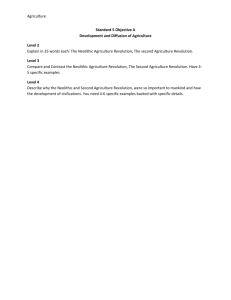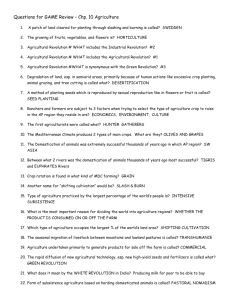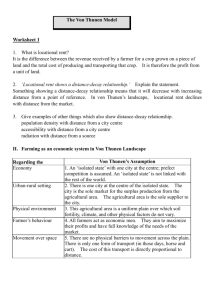April 4 and April 7, 2014
advertisement
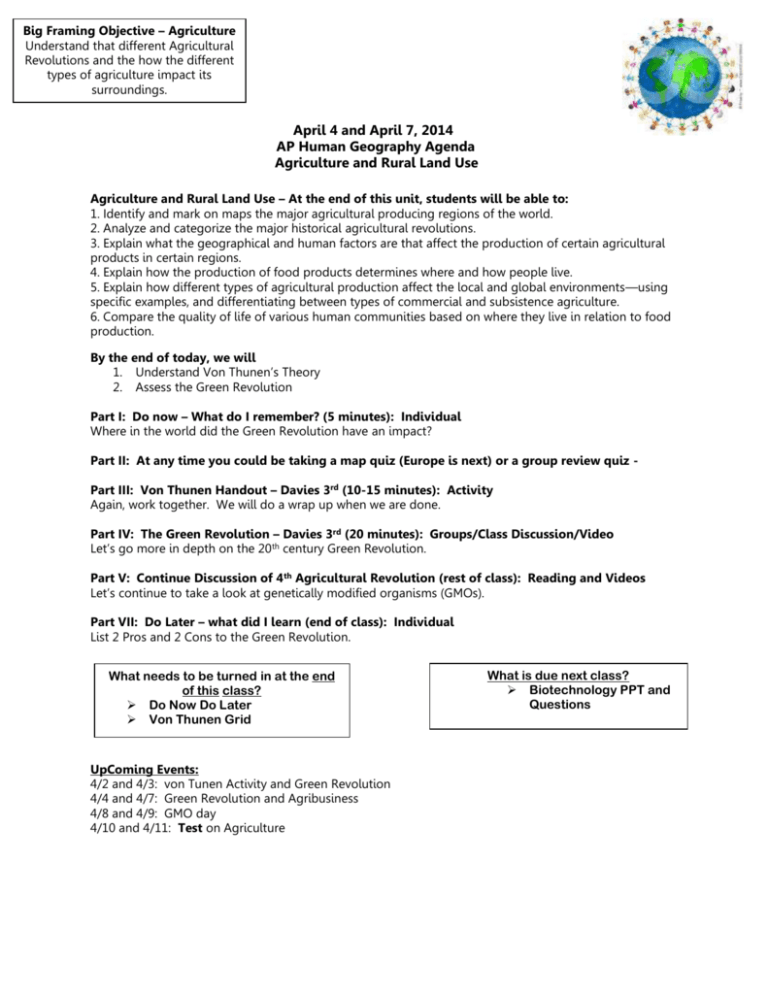
Big Framing Objective – Agriculture Understand that different Agricultural Revolutions and the how the different types of agriculture impact its surroundings. April 4 and April 7, 2014 AP Human Geography Agenda Agriculture and Rural Land Use Agriculture and Rural Land Use – At the end of this unit, students will be able to: 1. Identify and mark on maps the major agricultural producing regions of the world. 2. Analyze and categorize the major historical agricultural revolutions. 3. Explain what the geographical and human factors are that affect the production of certain agricultural products in certain regions. 4. Explain how the production of food products determines where and how people live. 5. Explain how different types of agricultural production affect the local and global environments—using specific examples, and differentiating between types of commercial and subsistence agriculture. 6. Compare the quality of life of various human communities based on where they live in relation to food production. By the end of today, we will 1. Understand Von Thunen’s Theory 2. Assess the Green Revolution Part I: Do now – What do I remember? (5 minutes): Individual Where in the world did the Green Revolution have an impact? Part II: At any time you could be taking a map quiz (Europe is next) or a group review quiz Part III: Von Thunen Handout – Davies 3rd (10-15 minutes): Activity Again, work together. We will do a wrap up when we are done. Part IV: The Green Revolution – Davies 3rd (20 minutes): Groups/Class Discussion/Video Let’s go more in depth on the 20th century Green Revolution. Part V: Continue Discussion of 4th Agricultural Revolution (rest of class): Reading and Videos Let’s continue to take a look at genetically modified organisms (GMOs). Part VII: Do Later – what did I learn (end of class): Individual List 2 Pros and 2 Cons to the Green Revolution. What needs to be turned in at the end of this class? Do Now Do Later Von Thunen Grid UpComing Events: 4/2 and 4/3: von Tunen Activity and Green Revolution 4/4 and 4/7: Green Revolution and Agribusiness 4/8 and 4/9: GMO day 4/10 and 4/11: Test on Agriculture What is due next class? Biotechnology PPT and Questions IF YOU LEARN ONLY 7 THINGS IN THIS UNIT (Agriculture): 1. 2. 3. 4. 5. 6. 7. Many of the world’s crop products are dictated by the climate of the region where they are grown. There were 4 Agricultural Revolutions that changed history. The first was the transition from hunting and gathering to planting and sustaining. The second increased productivity of farming through mechanization and access to markets due to better transportation. The third was the Green revolution whose intent was to increase food production in marginalized areas. The fourth and current revolution is the use of GMOs. Von Tunen’s model focuses on transportation. The distance and the weight of crops as well as their distance to market affect which ones are grown. There are 2 primary methods of farming in the world. Subsistence farming involves producing agricultural products for use by the farm family. Commercial farming involves the sale of agricultural products by the farm. Many of the settlement patterns in the US have been based on the agricultural possibilities of the areas. Modern agriculture is becoming more industrialized and more specialized than ever. The loss of the family farm is a direct result of the rise of feedlots and mega-farms used to produce enormous quantities of agricultural commodities. To compete with agribusiness in the US, many family farms are turning to sustainable methods of production, organic agriculture and catering to the local food movement. This Day in History 1818 Congress adopted a U.S. flag with one star for each state. 1841 President William Henry Harrison died from pneumonia, one month after his inauguration. 1905 Earthquake in Kangra, India, killed more than 20,000. 1945 The Ohrdruf death camp was liberated from Nazi occupation. 1949 The treaty establishing the North Atlantic Treaty Organization (NATO) was signed. 1968 Martin Luther King, Jr., was assassinated. 1973 The ribbon was cut to open the World Trade Center in New York City. 1979 Pakistan prime minister Zulfikar Ali Bhutto was executed by the military. 1981 Henry Cisneros became the mayor of San Antonio, Texas: the first Hispanic mayor of a major U.S. city. 1983 Sally Ride became the first U.S. woman in space aboard the space shuttle Challenger. INTERFAITH CONFLICTS Place China (Tibet) Nigeria Interfaith Boundary Tibetan Buddhism and Atheism Islam and Christianity India Hinduism and Sikhism India and Pakistan Former Yugoslavia Hinduism and Islam Central African Muslim and Christianity and Islam Conflict The atheist Chinese government id destroying Tibetan Buddhist monasteries, and overall trying to suppress the religion. Islam prevails in the northern region while Christianity and local religions prevail in the South. Lead to power based tensions for government control Sikhs in the NW state of Punjab demand autonomy from the Hinducontrolled government of India Pakistan was established as a Muslim state in 1948. Pakistan and India are fighting over territory called Jammu and Kashmir In the Yugoslavian civil wars of the 1990s, Serb leader Slobadan Milosevic tried to kill or evict the Muslim population in Bosnia and the other Serbian controlled lands in the region With its Muslim-Christian overtones risks escalating into sustained Republic Christianity Burma/Myanmar Buddhism and Islam violence along religious lines and spilling beyond the country’s borders, further destabilizing the whole region Though Muslims nationwide have been targeted, members of one particular ethnic group, the Rohingya, have borne the brunt of the violence. Many Buddhists view the Rohingya Muslims, who live along the border with Bangladesh, as illegal immigrants, even though many have been in Myanmar for generations. INTRAFAITH CONFLICTS Place Iraq Intrafaith Boundary Islam: Sunni and Shiite US Christian: Fundamentalism and moderate Christianity Christian: Protestant and Catholic Northern Ireland Conflict After the fall of the largely Sunni government controlled by Saddam Hussein, both Sunnis and Shiites are warring for control of the newly forming political landscape Christians have conflicted in the US over political-cultural issues such as homosexuality, evolution, and abortion. In some cases, violent tactics have been used British Colonialism deposited large numbers of Protestants in traditionally Catholic Northern Ireland. Has caused violent conflicts between the 2 groups in the regions


